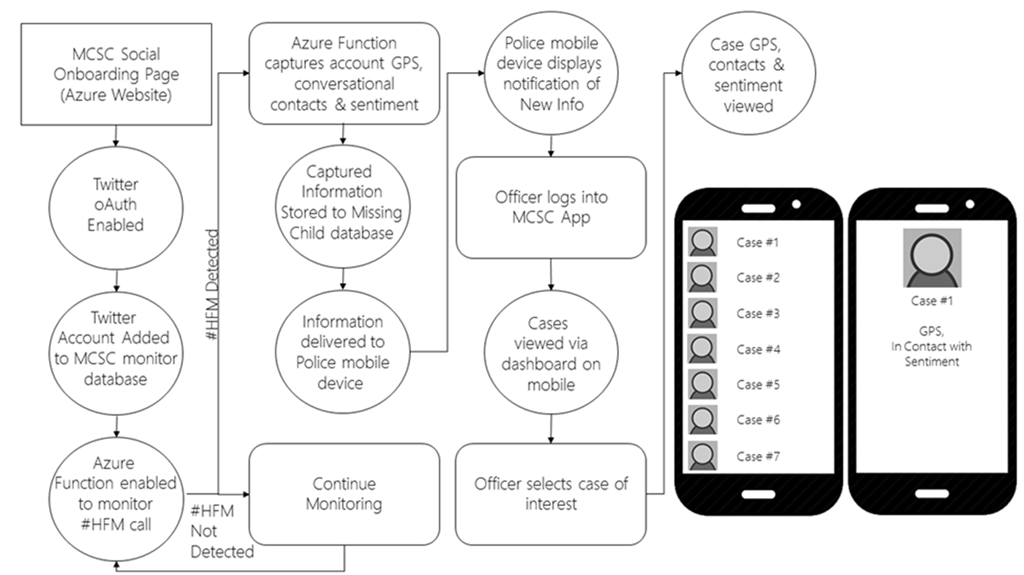Cloud4Good: How Azure helps speed up the search for Canada’s missing children
With so many stories focused on the business benefits of the cloud, we can easily overlook some of the most important and dramatic new social applications of emerging technology. And what could matter more than finding missing kids? Per the Missing Children Society of Canada in 2016 alone, a staggering 45,000 children went missing in Canada—including 150 cases of abduction.
Those horrible statistics only get more alarming when you discover the many challenges agencies face in their efforts to find and reunite children with their families. Over the course of several weeks last year, my colleagues and I at Microsoft had a chance to engage directly with Missing Children Society of Canada and the Calgary Police. We learned, firsthand, about their daunting challenge.
We all know that when a child goes missing, every second counts. Yet, the traditional method of gathering vital pieces of information—like what a child was wearing or where they were last seen—can take days, even weeks to research and collect. Imagine how insanely frustrating, how exasperating, that must feel for families, police, officials, friends, and other people involved.
And so, Missing Children Society of Canada, the Calgary Police, and Microsoft Canada got together to find a way to accelerate this vital research process. We set out to leverage the enormous popularity of social networks amongst Canada’s youth. Unfortunately, those same networks have also become havens for online predators. So, for all these reasons, finding a way to extract data automatically from all-important social media channels became job #1.
We quickly realized that Azure could aid in the search of missing children, without undermining anyone’s privacy. Our combined team decided to build Child Finder, a solution leveraging Azure Functions. Azure Functions allows users to run small pieces of code (or functions) in the cloud, without requiring infrastructure or even an application to run it.
The Child Finder solution
Parents or children register their social media accounts with Missing Children Society of Canada. If a registered child goes missing, the child or parent can use the #HFM (Help Find Me) command on the child’s social feed to deliver hugely valuable information, such as the child’s last known whereabouts, contacts, and the sentiment of conversations.
How it works
The Child Finder solution captures the information directly from the social media feed API provided by the parents or children and sends the information directly to law enforcement devices, notifying them that a child has gone missing in their area and providing them the social media information. Law enforcement officials simply login securely via Azure Active Directory to review the cases and get the info they need immediately.
Child Finder technical solution 
To ensure a successful project, the technical team at Microsoft Canada leveraged Azure Functions; Azure Web App; Service Bus; and DocumentDB database. An Infrastructure as a Service deployment, we leveraged Azure Resource Manager (ARM) templates to construct values and accelerate development. Azure Active Directory ensures “investigator-only” access and respects privacy. Parents can only initiate the #HFM (help find me) hashtag trigger with the correct username & password.
[video width="640" height="360" mp4="https://msdnshared.blob.core.windows.net/media/2016/12/MCSC60_final_02_sd_STREAM.mp4"][/video]
The impact
Suffice to say, we’re all enormously proud of the work done on this project. Judging from Amanda Pick’s reaction—she is the CEO, Missing Children Society of Canada—we have contributed to helping protect Canada’s children from harm. Our team intends to share our learning so that the project can evolve and so other teams can tackle similar challenges. As such, all code created for Child Finder has been stored on GitHub can be accessed at https://github.com/Missing-Children-Society-Canada.
For more information, please feel free to check out the following posts:
- Cloud4Good: Setting up Infrastructure as code on behalf of Missing Children Society of Canada by Pierre Roman
- Cloud4Good: Extracting Data from the Twitter API through Azure Functions by Jef King
- Cloud4Good: Cloning, Compiling and Deploying the Child Finder Xamarin Mobile App by MVP Mark Arteaga
Comments
- Anonymous
March 23, 2017
Hats off to anyone who contributes to helping protect Canada’s children from harm! - Anonymous
June 22, 2017
The github link is broken. Can you please update it?- Anonymous
June 22, 2017
The GitHub link has been updated.
- Anonymous